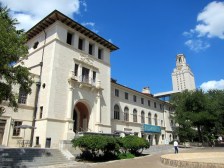With $60 million in NSF funding, U. of Texas will build the fastest supercomputer in higher ed
The University of Texas at Austin will soon have its own world-class supercomputer, courtesy of a $60 million award from the National Science Foundation that was announced Wednesday.
The Frontera supercomputer, aptly named after the Spanish word for “frontier,” is expected to go online in the summer of 2019. It’ll be housed in the Texas Advanced Computing Center , or TACC, but in assuming the place of the fastest supercomputer in U.S. higher education, school officials expect at least 10 partner universities — the California Institute of Technology, Cornell University, Princeton University, Stanford University, the University of Chicago, the University of Utah, University of California, Davis, Ohio State University, the Georgia Institute of Technology and Texas A&M University — to contribute to the science applications and technology team and general system upkeep.
“Supercomputers — like telescopes for astronomy or particle accelerators for physics — are essential research instruments that are needed to answer questions that can’t be explored in the lab or in the field,” said Dan Stanzione, executive director of TACC, in a statement.
Since 2006, TACC has built six supercomputers with funding from the NSF, with three debuting among the top 10 most powerful systems in the world and three others in the top 25. If Frontera were to go online today, it would run as the fifth-most powerful in the world. For context, a human would have to complete one calculation every second for one billion years to match Frontera’s output in just one second.
Stanzione and faculty at UT Austin’s Institute for Computational Engineering and Sciences (ICES) will oversee the initial experiments, which could including analyzing particle collisions from the Large Hadron Collider, advanced hurricane forecasting and complicated tasks in astronomy.
The computing power will be provided by an array of technology companies, with Dell EMC and Intel comprising the primary computing system. Data Direct Networks is contributing the primary storage system, and Mellanox, NVIDIA, Amazon, Google and Microsoft will also play technical and cloud-based roles.
Officials say the Frontera computer will run for five years past 2019. Some funds from the $60 million award will be used to test a computer to be built in the future that could operate 10 times faster than Frontera, for phase two of the project, officials said.




